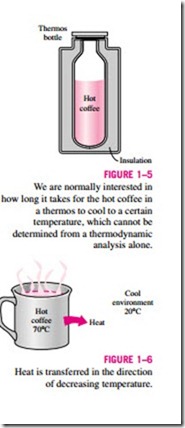HEAT TRANSFER
We all know from experience that a cold canned drink left in a room warms up and a warm canned drink put in a refrigerator cools down. This is accomplished by the transfer of energy from the warm medium to the cold one. The energy transfer is always from the higher temperature medium to the lower temperature one, and the energy transfer stops when the two mediums reach the same temperature.
Energy exists in various forms. In heat transfer, we are primarily interested in heat, which is the form of energy that can be transferred from one system to another as a result of temperature difference. The science that deals with the determination of the rates of such energy transfers is heat transfer.
You may be wondering why we need the science of heat transfer. After all, we can determine the amount of heat transfer for any system undergoing any process using a thermodynamic analysis alone. The reason is that thermodynamics is concerned with the amount of heat transfer as a system undergoes a process from one equilibrium state to another, and it gives no indication about how long the process will take. But in engineering, we are often interested in the rate of heat transfer, which is the topic of the science of heat transfer. A thermodynamic analysis simply tells us how much heat must be transferred to realize a specified change of state to satisfy the conservation of energy principle.
In practice we are more concerned about the rate of heat transfer (heat transfer per unit time) than we are with the amount of it. For example, we can determine the amount of heat transferred from a thermos bottle as the hot coffee inside cools from 90°C to 80°C by a thermodynamic analysis alone. But a typical user or designer of a thermos is primarily interested in how long it will be before the hot coffee inside cools to 80°C, and a thermodynamic analysis can- not answer this question. Determining the rates of heat transfer to or from a system and thus the times of cooling or heating, as well as the variation of the temperature, is the subject of heat transfer (Fig. 1–5).
for the science of heat transfer. The first law requires that the rate of energy transfer into a system be equal to the rate of increase of the energy of that sys- tem. The second law requires that heat be transferred in the direction of de- creasing temperature (Fig. 1–6). This is like a car parked on an inclined road must go downhill in the direction of decreasing elevation when its brakes are released. It is also analogous to the electric current flow in the direction of de- creasing voltage or the fluid flowing in the direction of decreasing pressure. The basic requirement for heat transfer is the presence of a temperature difference. There can be no net heat transfer between two mediums that are at the same temperature. The temperature difference is the driving force for heat transfer; just as the voltage difference is the driving force for electric current, and pressure difference is the driving force for fluid flow. The rate of heat transfer in a certain direction depends on the magnitude of the temperature gradient (the temperature difference per unit length or the rate of change of temperature) in that direction. The larger the temperature gradient, the higher the rate of heat transfer (Fig. 1–7).
